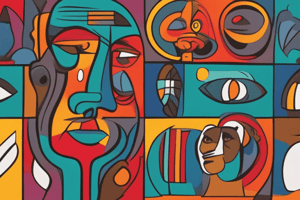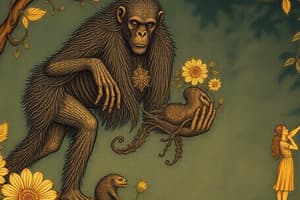Podcast
Questions and Answers
What is the significance of the discovery mentioned in the text?
What is the significance of the discovery mentioned in the text?
- It was the oldest hominid discovery at that time. (correct)
- It led to the discovery of plant remains nearby.
- It disproved the theory of evolution.
- It confirmed the existence of homo sapiens.
What is a hominid based on the context provided?
What is a hominid based on the context provided?
- A humanlike creature that walked upright. (correct)
- A species of bird found in Africa.
- A type of prehistoric plant.
- A sea-dwelling creature.
How do scientists typically react when new archaeological discoveries are made?
How do scientists typically react when new archaeological discoveries are made?
- They never find new discoveries in archaeology.
- They ignore the new findings and continue with their previous theories.
- They keep the discoveries secret from the public.
- They revise their ideas about prehistoric human life. (correct)
In what region did the earliest hominids live?
In what region did the earliest hominids live?
What was Leakey's reaction upon discovering a hominid skull?
What was Leakey's reaction upon discovering a hominid skull?
Which hominid was likely the first to leave Africa?
Which hominid was likely the first to leave Africa?
What is the meaning of 'Homo sapiens sapiens'?
What is the meaning of 'Homo sapiens sapiens'?
What evidence suggests that Neanderthals were possibly the first to bury their dead?
What evidence suggests that Neanderthals were possibly the first to bury their dead?
When did Homo sapiens sapiens likely appear in Africa?
When did Homo sapiens sapiens likely appear in Africa?
What is the significance of Homo erectus having arms and legs in modern human proportion?
What is the significance of Homo erectus having arms and legs in modern human proportion?
What is a distinguishing feature of the human species mentioned in the text?
What is a distinguishing feature of the human species mentioned in the text?
Which hominid species was replaced by Homo sapiens sapiens?
Which hominid species was replaced by Homo sapiens sapiens?
What do microscopic and biological analyses of organic remains left on tools and weapons provide insight into?
What do microscopic and biological analyses of organic remains left on tools and weapons provide insight into?
In which age did humans use simple stone tools, according to the text?
In which age did humans use simple stone tools, according to the text?
What was one of the primary reasons for the slow spread of Homo sapiens sapiens around the globe?
What was one of the primary reasons for the slow spread of Homo sapiens sapiens around the globe?
Which of the following statements accurately reflects a recent scientific discovery mentioned in the text?
Which of the following statements accurately reflects a recent scientific discovery mentioned in the text?
What model proposes that the development from earlier hominids to anatomically modern humans occurred in different locations?
What model proposes that the development from earlier hominids to anatomically modern humans occurred in different locations?
What new information is ancient deoxyribonucleic acid (DNA) providing on human evolution?
What new information is ancient deoxyribonucleic acid (DNA) providing on human evolution?
Why did the nickname 'Lucy' for the female skeleton suggest that she was the common ancestor for early human life?
Why did the nickname 'Lucy' for the female skeleton suggest that she was the common ancestor for early human life?
How do archaeologists and anthropologists determine the ages of fossils and artifacts?
How do archaeologists and anthropologists determine the ages of fossils and artifacts?
What distinguishes Homo habilis from Australopithecus based on the text?
What distinguishes Homo habilis from Australopithecus based on the text?
What aspect of early human development stages do scientists identify using remains and technology?
What aspect of early human development stages do scientists identify using remains and technology?
What did Donald Johanson's findings suggest about the evolution of walking upright and developing large brains in hominids?
What did Donald Johanson's findings suggest about the evolution of walking upright and developing large brains in hominids?
What period did Homo erectus, an 'upright human', exist in?
What period did Homo erectus, an 'upright human', exist in?
What crucial aspect did Lucy's small brain size highlight in terms of human evolution as discussed in the text?
What crucial aspect did Lucy's small brain size highlight in terms of human evolution as discussed in the text?
Flashcards are hidden until you start studying





